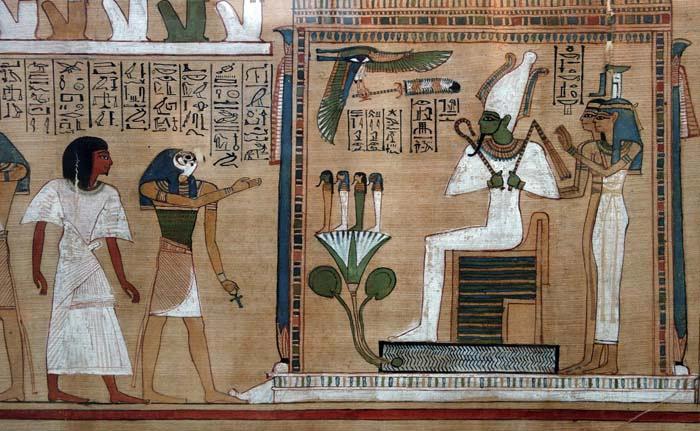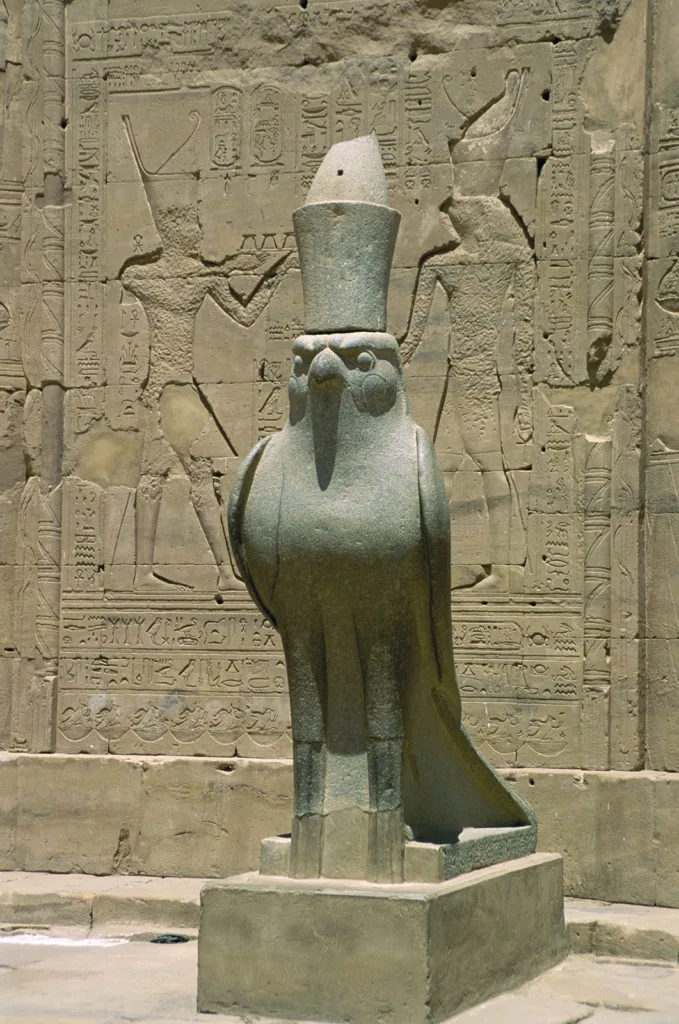Horus, also known as Heru or Har, was one of the most significant deities in Ancient Egypt. He was revered for his association with kingship and the sky, and worshiped from the late prehistoric era until the Ptolemaic Kingdom and Roman Egypt.
One of the most recognizable depictions of Horus is as a falcon-headed god wearing a double crown. The pharaohs of Egypt were often associatd with Horus, as they were believed to be the earthly embodiment of the god. As such, many kings erected temples dedicated to him, and endowed them with lands and clergy to serve his cult.
Horus was also associated with the sun, and many pharaohs added sun god chapels to their own memorial temples throughout the country. However, by the New Kingdom, the cult of Amun, the political god of the Empire, began to overshadow Horus’ importance.
Despite this, Horus remained a popular deity throughout Egypt, and was worshiped in many towns and cities, including Pe, Bendet, and Khem. In fact, there were many falcon gods before Horus, but eventually he came to represent them all.
Horus was worshiped until the end of the Pre-Dynastic period in Upper Egypt, particularly in the city of Edfu, where a Ptolemaic temple was built in his honor.
Worship of Horus typically involved offerings of food, drink, and incense, as well as the recitation of prayers and hymns. The god was also believed to have healing powers, and many pilgrims visited his temples seeking relief from illness and disease.
In addition to his role as a deity of kingship and the sky, Horus was also associated with protection and strength. He was believed to watch over the pharaoh and the people, and to provide them with the power to overcome their enemies.
Horus was a complex and multifaceted deity who played an important role in the religious and cultural life of Ancient Egypt. His worship was widespread and enduring, and his influence can still be felt today in the many depictions of him that survive in art and literature.
Worship of Horus
Horus was widely worshipped by the ancient Egyptians from the prehistoric times until the Ptolemaic and Roman periods. As a god of kingship and the sky, he played a crucial role in the mythology and religion of ancient Egypt. Horus was believed to be the son of Osiris and Isis, and the grandson of Geb and Nut. He was also associated with the pharaohs of Egypt, who were considered to be his earthly representatives and incarnations.
Horus was depicted in various forms, including as a falcon or a falcon-headed man, wearing the double crown of Upper and Lower Egypt. He was also associated with the sun and the moon, and was believed to control the cycles of day and night. Horus was often depicted in battle with his archrival Set, who had killed his father Osiris and usurped the throne of Egypt.
The worship of Horus was widespread throughout Egypt, and many temples and shrines were built in his honor. The most famous of these was the Temple of Horus at Edfu, which was built duing the Ptolemaic period and is considered to be one of the best-preserved ancient temples in Egypt. Other important temples dedicated to Horus include the Temple of Horus at Kom Ombo and the Temple of Horus at Behdet.
Horus was also an important figure in Egyptian funerary religion, as he was believed to protect the souls of the dead and guide them through the afterlife. He was often depicted in tombs and funerary texts, and was associated with the god Anubis, who was responsible for embalming and mummification.
Horus was a significant deity in ancient Egyptian religion and was widely worshipped throughout Egypt for thousands of years. His association with kingship, the sky, and the afterlife made him a central figure in Egyptian mythology and religion, and his temples and shrines were among the most important and elaborate in ancient Egypt.

Source: ancient-egypt-online.com
Worship of Horus
Horus was a significant deity in ancient Egyptian mythology, and he was worshipped by a vast number of people in Egypt. Horus was considered to be the god of the sky, hunting, war, and protection. He was also believed to be the son of Osiris and Isis, two other prominent gods in Egyptian mythology.
The followers of Horus were mostly the common people of Egypt, who considered him to be a powerful protector and a symbol of strength and courage. The pharaohs of Egypt were also associaed with Horus, as they believed that they were the earthly embodiment of the god.
The worship of Horus was not limited to Egypt alone, but it spread to other parts of the world, such as Greece and Rome. Horus was often associated with other deities in these cultures, such as Apollo and Mars, due to their similar roles as gods of war and protection.
Horus was worshipped by the people of Egypt, including the pharaohs, and his worship spread to other parts of the world, where he was associated with other deities.
Worship of the Egyptian Sun God Ra
Ra was one of the most significant deities in ancient Egyptian religion. The worship of Ra began in the Early Dynastic Period (c. 3150-2686 BCE) and continued until the end of the Ptolemaic Period (30 BCE-395 CE). The Egyptians believed that Ra was the creator of the world, and he was often depicted with a solar disk on his head, representing the sun.
The Egyptians worshiped Ra in many ways, including building temples and shrines in his honor. Kings would erect temples for him and endow them with lands and clergy to serve his cult. They also added sun god chapels to their own memorial temples throughot the country. The most famous temple dedicated to Ra was the Temple of Amun-Ra at Karnak, which was built during the New Kingdom (c. 1500-1000 BCE).
The priests of Ra would perform daily rituals to honor him, including offerings of food, drink, and incense. They believed that these offerings would sustain the god and ensure his continued favor. The priests also performed purification rituals to cleanse the temple and its surroundings.
During the New Kingdom, the cult of Amun, the political god of the Empire, tried to overshadow Ra’s importance. However, Ra remained an important deity throughout Egyptian history, and his worship continued even after the decline of the pharaonic civilization.
The worship of Ra was an essential aspect of ancient Egyptian religion. It involved building temples, making offerings, and performing daily rituals to honor the god. Despite attempts to diminish his importance, Ra remained a significant deity throughout Egyptian history.
Worship of Horus
Horus was a significant god in ancient Egyptian mythology and was widely worshiped througout the country. He was especially revered in the towns of Pe, Bendet, and Khem. It is essential to note that Horus was not the only falcon god in the Egyptian pantheon, but he eventually came to represent all of them.
Horus was worshiped until the end of the Pre-Dynastic period. One of the most famous temples dedicated to Horus was located in the town of Edfu, in Upper Egypt (south). This temple was built during the Ptolemaic period and was considered one of the most well-preserved temples of ancient Egypt.
Moreover, Horus was also associated with the pharaohs of Egypt, and his cult was closely tied to the ruling class. The pharaohs were believed to be the manifestation of Horus, and they were responsible for maintaining his worship in the temples throughout the land.
Horus was worshiped all over Egypt, but his worship was particularly significant in Pe, Bendet, and Khem. His cult was closely tied to the pharaohs, and his most famous temple was located in Edfu.

Conclusion
Horus was one of the most significant ancient Egyptian deities, worshipped from prehistoric times until the Ptolemaic Kingdom and Roman Egypt. He was associated with kingship and the sky, and often depicted as a falcon-headed god with a double crown. The pharaohs of Egypt were believed to be the earthly embodiment of Horus, and they erected temples for him all over the country. Horus was worshiped until the end of the Pre-Dynastic period, and his cult remained popular throghout Egyptian history. Today, Horus is remembered as one of the most important gods of ancient Egypt, and his legacy continues to influence art, mythology, and culture around the world.
